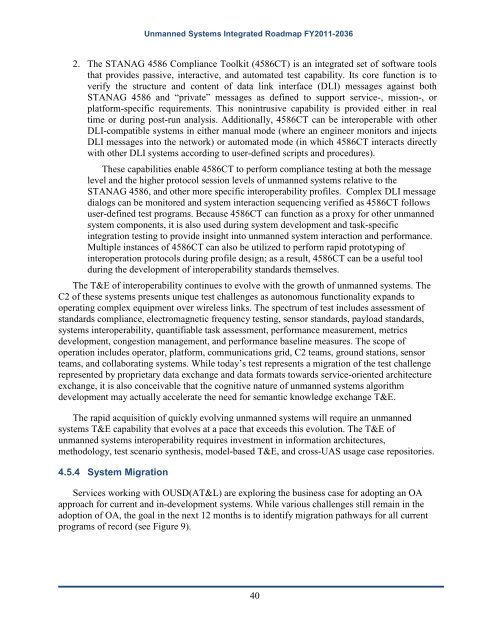Unmanned Systems Integrated Roadmap FY2011-2036 - Defense ...
Unmanned Systems Integrated Roadmap FY2011-2036 - Defense ...
Unmanned Systems Integrated Roadmap FY2011-2036 - Defense ...
You also want an ePaper? Increase the reach of your titles
YUMPU automatically turns print PDFs into web optimized ePapers that Google loves.
<strong>Unmanned</strong> <strong>Systems</strong> <strong>Integrated</strong> <strong>Roadmap</strong> <strong>FY2011</strong>-<strong>2036</strong><br />
2. The STANAG 4586 Compliance Toolkit (4586CT) is an integrated set of software tools<br />
that provides passive, interactive, and automated test capability. Its core function is to<br />
verify the structure and content of data link interface (DLI) messages against both<br />
STANAG 4586 and “private” messages as defined to support service-, mission-, or<br />
platform-specific requirements. This nonintrusive capability is provided either in real<br />
time or during post-run analysis. Additionally, 4586CT can be interoperable with other<br />
DLI-compatible systems in either manual mode (where an engineer monitors and injects<br />
DLI messages into the network) or automated mode (in which 4586CT interacts directly<br />
with other DLI systems according to user-defined scripts and procedures).<br />
These capabilities enable 4586CT to perform compliance testing at both the message<br />
level and the higher protocol session levels of unmanned systems relative to the<br />
STANAG 4586, and other more specific interoperability profiles. Complex DLI message<br />
dialogs can be monitored and system interaction sequencing verified as 4586CT follows<br />
user-defined test programs. Because 4586CT can function as a proxy for other unmanned<br />
system components, it is also used during system development and task-specific<br />
integration testing to provide insight into unmanned system interaction and performance.<br />
Multiple instances of 4586CT can also be utilized to perform rapid prototyping of<br />
interoperation protocols during profile design; as a result, 4586CT can be a useful tool<br />
during the development of interoperability standards themselves.<br />
The T&E of interoperability continues to evolve with the growth of unmanned systems. The<br />
C2 of these systems presents unique test challenges as autonomous functionality expands to<br />
operating complex equipment over wireless links. The spectrum of test includes assessment of<br />
standards compliance, electromagnetic frequency testing, sensor standards, payload standards,<br />
systems interoperability, quantifiable task assessment, performance measurement, metrics<br />
development, congestion management, and performance baseline measures. The scope of<br />
operation includes operator, platform, communications grid, C2 teams, ground stations, sensor<br />
teams, and collaborating systems. While today’s test represents a migration of the test challenge<br />
represented by proprietary data exchange and data formats towards service-oriented architecture<br />
exchange, it is also conceivable that the cognitive nature of unmanned systems algorithm<br />
development may actually accelerate the need for semantic knowledge exchange T&E.<br />
The rapid acquisition of quickly evolving unmanned systems will require an unmanned<br />
systems T&E capability that evolves at a pace that exceeds this evolution. The T&E of<br />
unmanned systems interoperability requires investment in information architectures,<br />
methodology, test scenario synthesis, model-based T&E, and cross-UAS usage case repositories.<br />
4.5.4 System Migration<br />
Services working with OUSD(AT&L) are exploring the business case for adopting an OA<br />
approach for current and in-development systems. While various challenges still remain in the<br />
adoption of OA, the goal in the next 12 months is to identify migration pathways for all current<br />
programs of record (see Figure 9).<br />
40

















